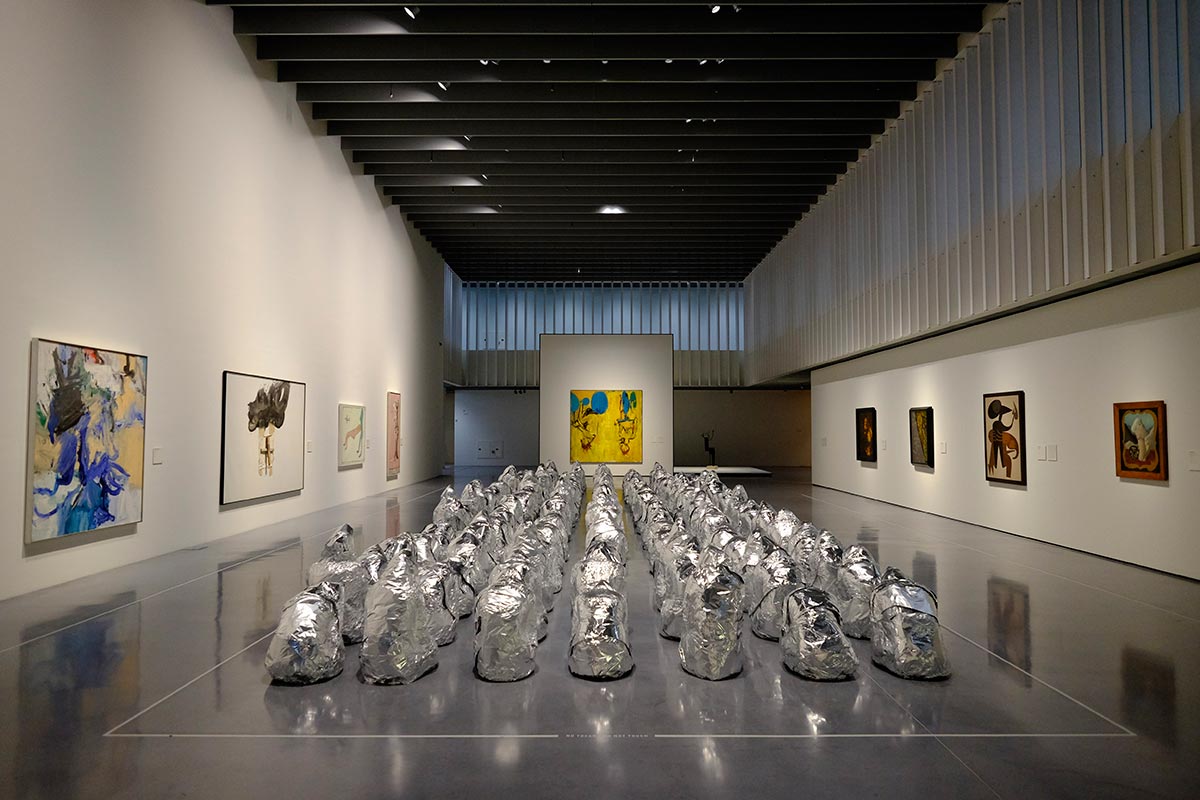A renowned contemporary art collection in a futuristic setting of polished steel girders and towering glass façades: the Pompidou Málaga is very much a satellite forged in the image of its Parisian mothership. From the outside, the structure – which was actually designed over a decade ago by Spanish architecture firm, L35 – resembles an elegant Rubik’s cube, combining French chic with a twist of vibrant, Mediterranean colour. It is a welcome addition to northern France’s Pompidou-Metz, the hitherto sole offshoot of Renzo Piano’s glorious Centre Pompidou, and a sign of the increasing global dominance of Western art institutions.
The Pompidou Málaga itself is, for now, only a semi-permanent venture. Over the next five years, around 100 works taken from the Pompidou’s 100,000-strong collection will be exhibited in ‘El Cubo’s underground galleries, rotating every couple of years. The first installation cycle, simply titled ‘The Collection’, is one to savour. Unlike Málaga’s recently opened branch of St. Petersburg’s State Russian Museum, whose permanent offering appears to be the relatively uninspiring dregs of their stockpile, this is an exciting group of works, including a number of Picassos and pieces by Giacometti, Magritte, Bacon, Baselitz, de Kooning and Kahlo.
Installation view of ‘The Collection’, Centre Pompidou Málaga, March 2015. Photo © Carlos Criado / Ayuntamiento de Málaga

The springboard of ‘The Collection’ is Pablo Picasso, the city’s beloved genius, who was born just a few minutes up the road at Plaza de la Merced, and was a Malagueño until the age of 19, before migrating to Paris. A canny, if somewhat obvious, move by the curators has been to play heavily on this history. ‘These images, which bear the mark of the radical upheaval blown into the art of our time by Málaga’s son, Pablo Picasso,’ reads the opening plaque, ‘carry a message important to us all: the expression of humanity, in all its uniqueness and diversity.’
The exhibition’s various sections explore various discourses on identity and the human body: ‘Metamorphoses’, ‘Self Portraits’, ‘The Man without a Face’, the ‘Political Body’, and the ‘Body in Pieces’. It’s all fairly safe territory – this is not avant-garde art theory – but it’s nuanced enough to intrigue, and there’s a playful edge to it. Picasso’s singular, affecting Hat with Flowers (1940) opens proceedings and makes a clear statement about the subjectivity of portraiture. Pierrick Sorin’s It’s Really Nice (1998) consists of dozens of small screens with the warped faces of strangers, who purse their lips and blink awkwardly – perhaps a mirror to visitors. John Currin’s The Moroccan (2001) adds some fish-on-head surrealism, Tony Oursler’s CCTV-state-replicating Switch (1996) some alienation. Rineke Dijkstra’s film I See A Woman Crying (2008) is enchanting, showing English school-kids reacting to Picasso’s La Femme Qui Pleure (1937) – ‘mortified’, ‘horrified’, ‘gobsmacked’ – in their coarse Scouse accents.
‘The Collection’ matures and gains clout as it progresses. Chagall’s Dimanche (1952–54) is a wonderful self-portrait of the artist and his wife as luminous stars, returning to the sun that is Paris after the Second World War. Frida Kahlo’s The Frame (1938), meanwhile, combines bold primary colours with birds and flowers in the style of Mexican folk art – André Breton described it as a ‘ribbon around a bomb’. The Israeli artist Sigalit Landau’s Barbed Hula (2001) is visceral performance art, suggesting the pain of borders beyond the skin. Other classics include Giacometti’s cratered bronze Femme Nue Debout (1954), Bruce Nauman’s 1969 Lip Sync, and René Magritte’s blunt but brilliant deconstruction of the male gaze, Le Viol (1945).
It’s unlikely that the Pompidou Málaga will have the same transformative effect as the Guggenheim did on Bilbao – even the city’s mayor Francisco de la Torre Prados has admitted as much. But the gallery’s use of interactive displays – mirrors, masks – is a notable attempt to ensure the local community is engaged, rather than just the globetrotters. With such a rich pool of work to delve into, and an interesting line-up of temporary programmes – including drawings by Joan Miró, Dadaist film, and female photographers of the 1920s and ‘30s – the signs are that this expedition to the Costa del Sol will endure.
Find out more about the Centre Pompidou Málaga.
Related Articles
Forum: Should we be cynical about international museum franchises?
Review: Guggenheim Bilbao lets its collection speak for itself







